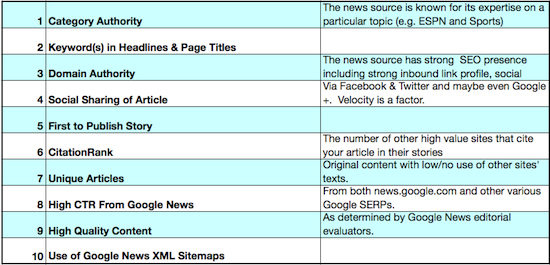Reaching your audience requires a true desire to communicate with humans. The idea of cranking out computer generated content and thinking Google is going to be fooled is long gone. Doing what it takes to connect with actual flesh and blood through quality content, good design and social media connections will take you a good way with rankings today. Read more here
Google News ranking factors have long been shrouded in mystery. However, a recent report aims to penetrate that shroud by compiling survey data from content optimizers who work at top news outlets. Here's what the report shows.
As an executive rundown: It's vital to have a strong reputation in the category of the content; use your keywords in the title, headlines, ledes, and content; optimize your articles for social sharing; produce unique, user-driven content; focus on getting a positive Google News user response (high CTR, low bounce); and use the Google News sitemap. Additionally, standard SEO tactics – especially building links to both your core domain and your targeted content – remain relevant.
Before moving on to a full breakdown, let's take a quick look at how these conclusions were formed.
The study, presented by Local SEO Guide, Perfect Market, and newsknife, brings together opinions from the 17 experts in the industry. Among those experts are John Shehata of ABC News, Eleanor Hong of ESPN.com, Simon Heseltine of the Huffington Post, and Topher Kohan of CNN. The full list of contributors can be seen here.
While the exact nature of the survey wasn't released, it's clear that not all items on the list were viewed as priorities for all SEOs involved; several actively dispute the relevance of factors included on the full list in their commentary. To take best advantage of the findings, it's important to prioritize the items on the top 10 news ranking factors list and focus only on the first few items noted on the additional pages.
Alternatively, you can just take a look at the following key factors.
Rather than going through every item on every list the report compiled, let's walk through the things you can apply to your site with minimum effort and maximum results. Here are key accessible ranking factors and how you can implement them.
• Use keywords in your headlines, page titles, ledes, and meta descriptions. After doing some basic research on the key terms related to the content, be sure to include a targeted keyword or keywords in your title. To maximize the weight of keywords headlines, try to keep your headline brief (ABC's John Sehata recommended 10 words as a maximum).
Additionally, it was suggested that you use synonyms and related words in both the areas mentioned above and in the main body on the content. As always, the use of synonymous terms should never be added to content in a way that makes the message redundant.
• Optimize your core domain. Use the standard SEO tactics to increase the number of inbound links to the main domain, create an optimized link architecture, and improve the social feedback on the core domain.
Adam Audette of RKG emphasized the importance of building links by saying, "True internal pagerank […] is still paramount to Google’s approach to search."
• Optimize the content for social. The survey's respondents suggested that both the volume and velocity of social shares were important. As such, it's important to make social sharing easy (e.g., sharing buttons in a visible place on the content) and to get the sharing started yourself.
As AJ Kohn of Blind Five Year Old said, "Tweet first, revise the article later." Even respondents who didn't feel as strongly anticipate that social will become a much heavier factor in the coming months and years.
• Get to the story first. It's simple enough to understand: breaking the story helps your content succeed both by improving your long-term position and by giving your content a (brief) window without competition.
• Work for citations. Citations from reputed sources are seen as a major element in a given article's rank. It's important to publicize your content in channels that are likely to lead to citations, so contact any group that's using elements of your content without citation, and – most importantly – provide content worth citing.
• Provide unique content. Keep the amount of quoted material to a minimum and provide as much fresh insight, media, and original journalism on the topic as is possible.
• Optimize your headline and ledes for CTR and low bounce-rate. Create snappy, relevant headlines, enticing leads, and interesting content. The respondents agreed that Google looks at the tracked CTR from both Google News and other networked outlets to determine the user value of content. Additionally, bounces back to the Google News page is likely used to determine the rate of success.
• Produce quality content. Beyond the normal importance of quality, Google News editorial evaluators will be judging your content to determine whether it's up to snuff. Your site can and will be pulled from News entirely if the evaluators think your content is thin.
As should be evident from many of the factors noted here, quality content will also improve the success of your site by altering both tracked user behaviors (e.g., social sharing and CTR) and general optimization (e.g., you're more likely to get inbound links and article citations).
• Use standard optimization practices. Items like page load time, image optimization, ad-to-content ratio, and content length still apply. For the sake of news content, ABC News' John Shehata recommends 200 to 800 words as a general rule – a rule, he notes, with plenty of exceptions.
• Use the Google News Sitemap. This sitemap format, described in this official help page, allows publishers to specify additional details (genre, geo-location, the name of the publication, etc.), provide rich metadata that makes the News results entry more enticing to users, and increase the speed at which their content is indexed.
AJ Kohn described the importance of this tool by saying, "The Google News Sitemap: Learn it. Know it. Live it."


